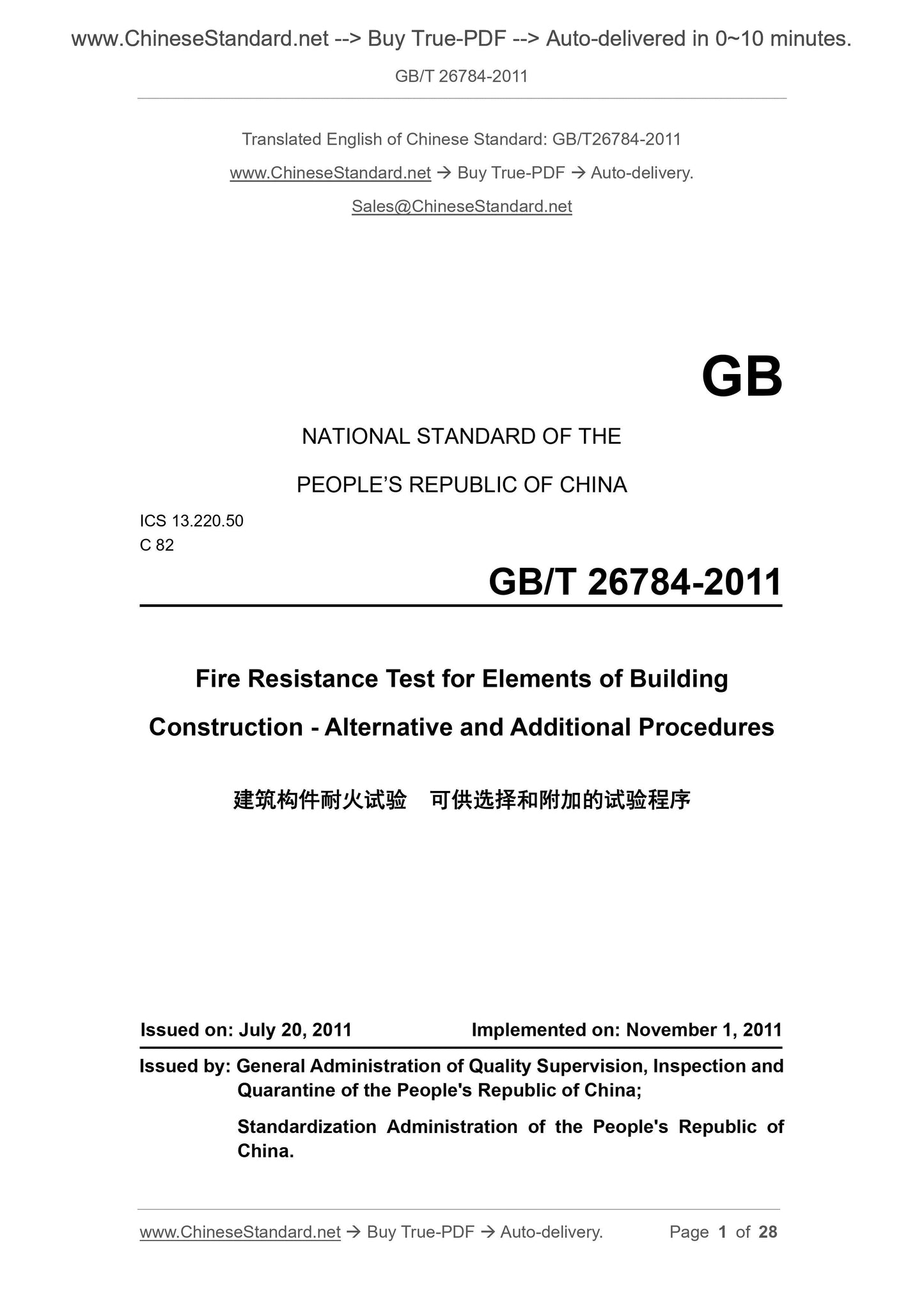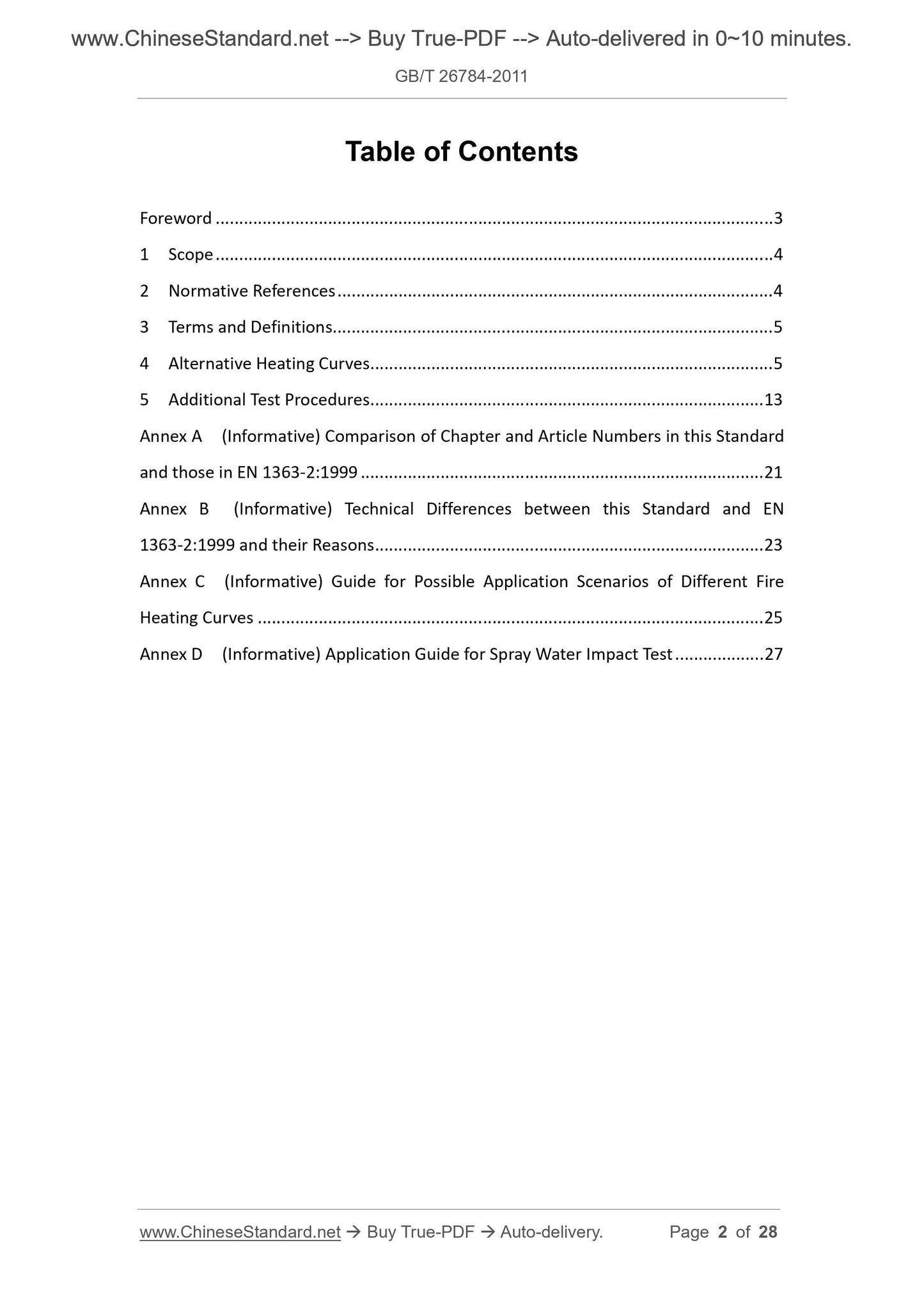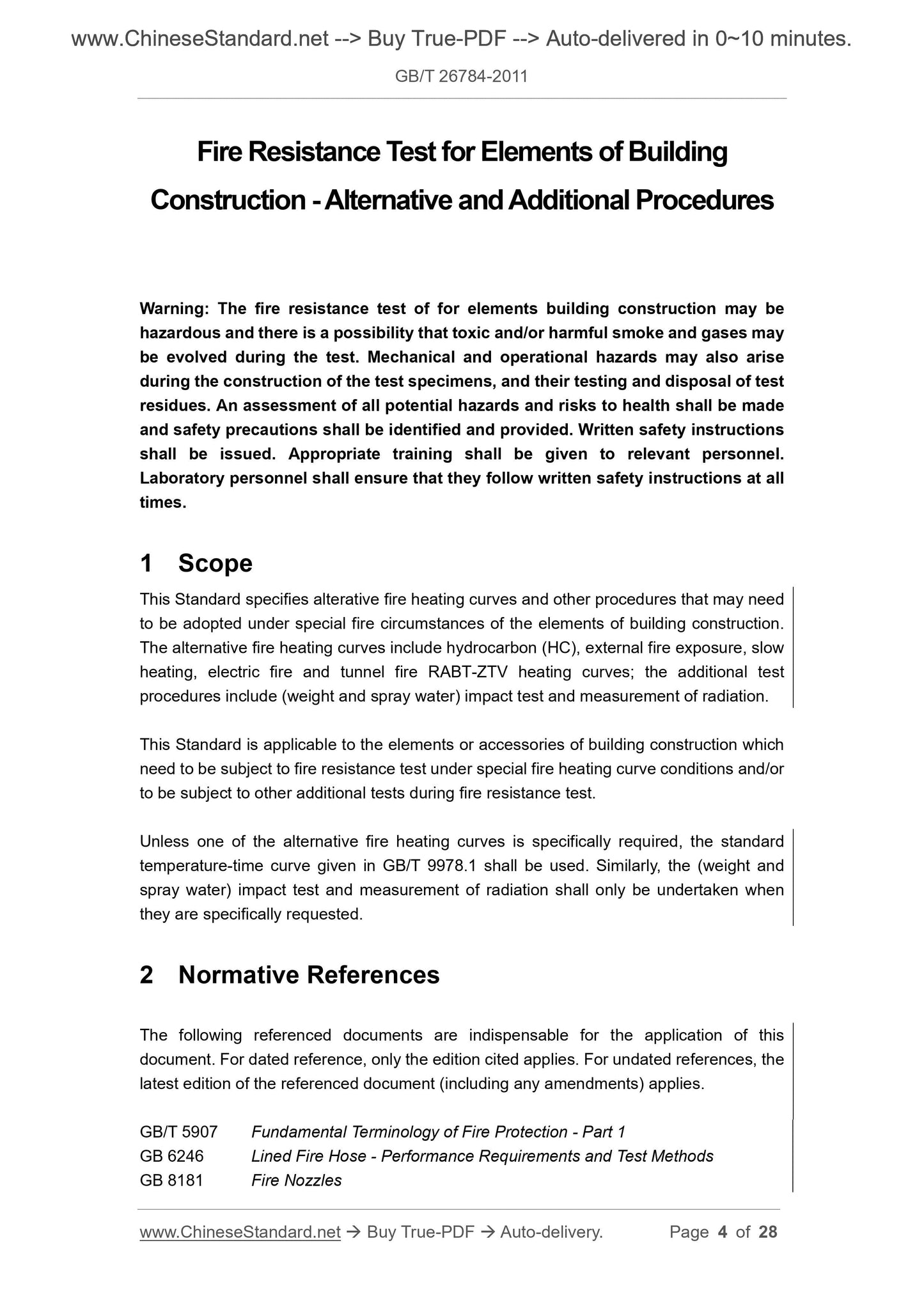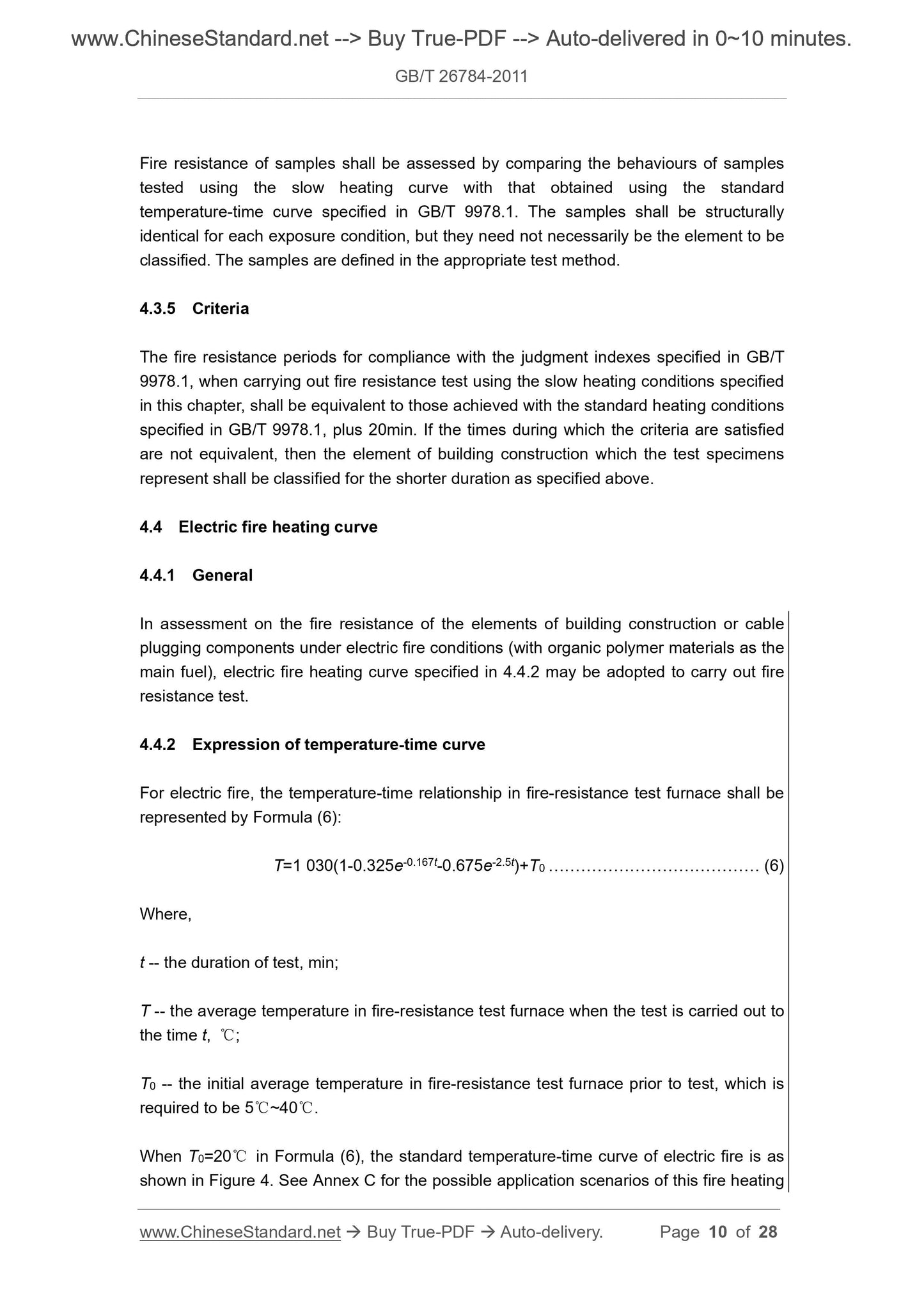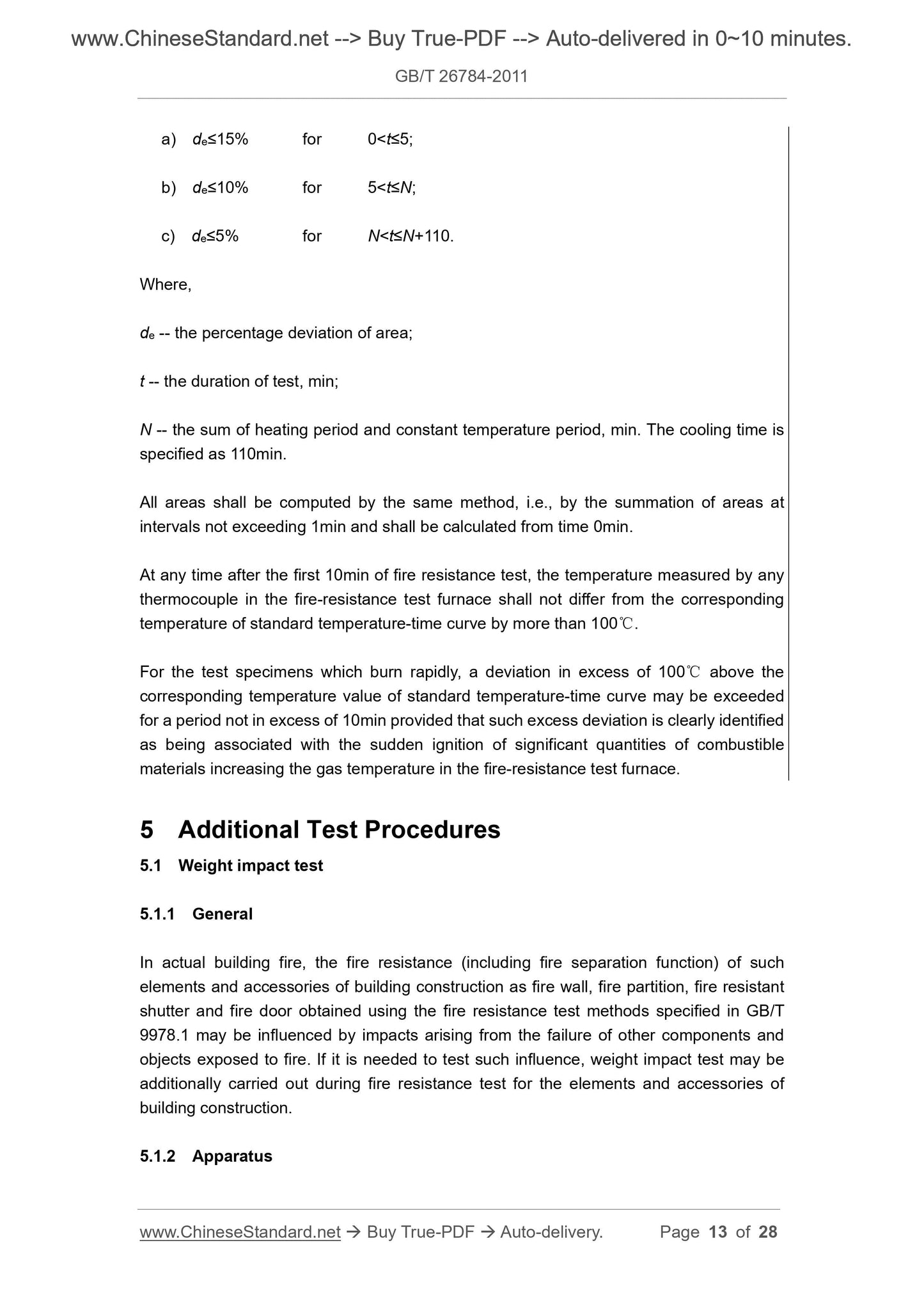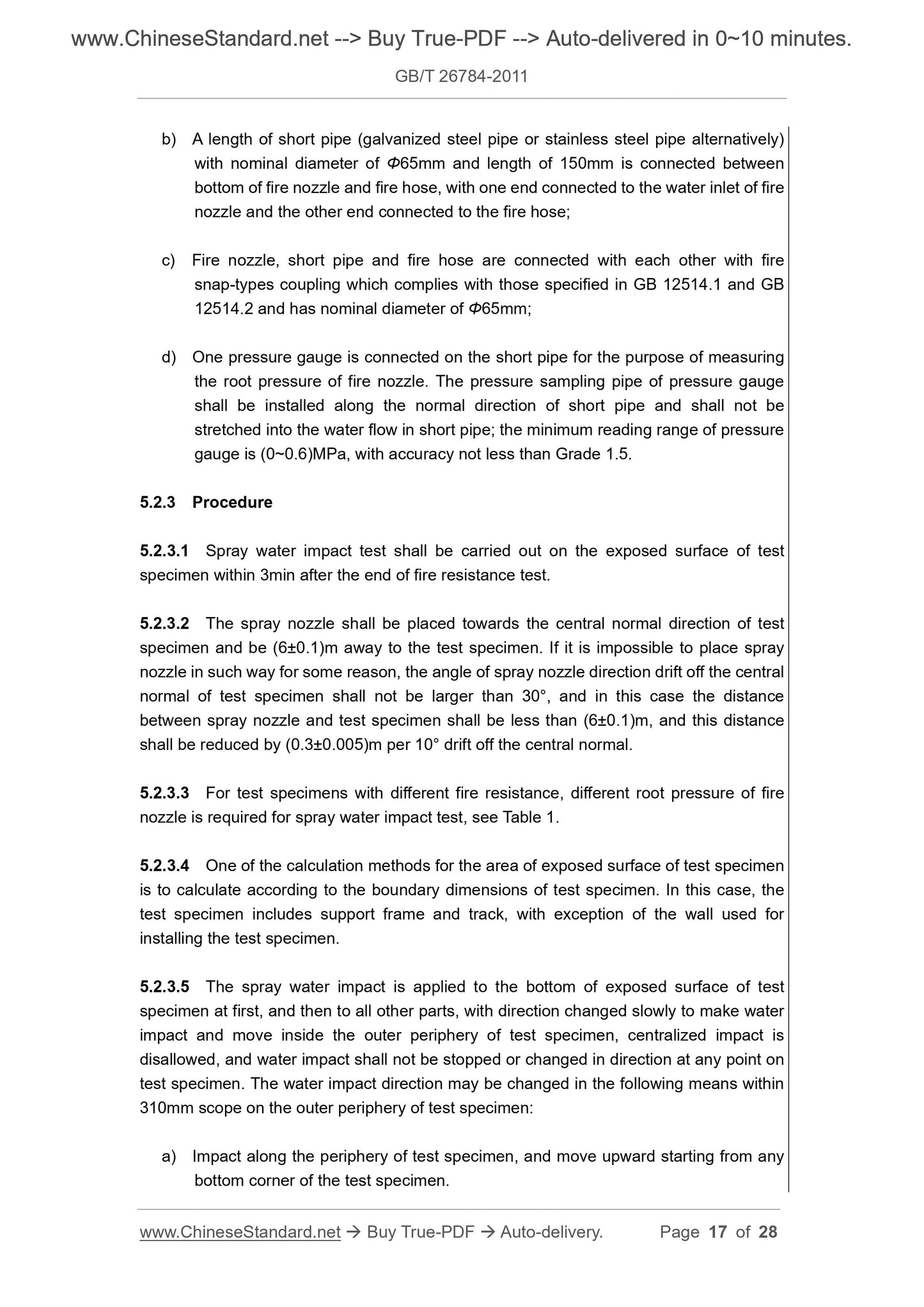1
/
of
6
PayPal, credit cards. Download editable-PDF and invoice in 1 second!
GB/T 26784-2011 English PDF (GBT26784-2011)
GB/T 26784-2011 English PDF (GBT26784-2011)
Regular price
$145.00 USD
Regular price
Sale price
$145.00 USD
Unit price
/
per
Shipping calculated at checkout.
Couldn't load pickup availability
Delivery: 3 seconds. Download true-PDF + Invoice.
Get QUOTATION in 1-minute: Click GB/T 26784-2011
Historical versions: GB/T 26784-2011
Preview True-PDF (Reload/Scroll if blank)
GB/T 26784-2011: Fire resistance test for elements of building construction -- Alternative and additional procedures
GB/T 26784-2011
GB
NATIONAL STANDARD OF THE
PEOPLE’S REPUBLIC OF CHINA
ICS 13.220.50
C 82
Fire Resistance Test for Elements of Building
Construction - Alternative and Additional Procedures
ISSUED ON: JULY 20, 2011
IMPLEMENTED ON: NOVEMBER 1, 2011
Issued by: General Administration of Quality Supervision, Inspection and
Quarantine of the People's Republic of China;
Standardization Administration of the People's Republic of
China.
Table of Contents
Foreword ... 3
1 Scope ... 4
2 Normative References ... 4
3 Terms and Definitions ... 5
4 Alternative Heating Curves ... 5
5 Additional Test Procedures ... 13
Annex A (Informative) Comparison of Chapter and Article Numbers in this Standard
and those in EN 1363‐2:1999 ... 21
Annex B (Informative) Technical Differences between this Standard and EN
1363‐2:1999 and their Reasons ... 23
Annex C (Informative) Guide for Possible Application Scenarios of Different Fire
Heating Curves ... 25
Annex D (Informative) Application Guide for Spray Water Impact Test ... 27
Fire Resistance Test for Elements of Building
Construction - Alternative and Additional Procedures
Warning: The fire resistance test of for elements building construction may be
hazardous and there is a possibility that toxic and/or harmful smoke and gases may
be evolved during the test. Mechanical and operational hazards may also arise
during the construction of the test specimens, and their testing and disposal of test
residues. An assessment of all potential hazards and risks to health shall be made
and safety precautions shall be identified and provided. Written safety instructions
shall be issued. Appropriate training shall be given to relevant personnel.
Laboratory personnel shall ensure that they follow written safety instructions at all
times.
1 Scope
This Standard specifies alterative fire heating curves and other procedures that may need
to be adopted under special fire circumstances of the elements of building construction.
The alternative fire heating curves include hydrocarbon (HC), external fire exposure, slow
heating, electric fire and tunnel fire RABT-ZTV heating curves; the additional test
procedures include (weight and spray water) impact test and measurement of radiation.
This Standard is applicable to the elements or accessories of building construction which
need to be subject to fire resistance test under special fire heating curve conditions and/or
to be subject to other additional tests during fire resistance test.
Unless one of the alternative fire heating curves is specifically required, the standard
temperature-time curve given in GB/T 9978.1 shall be used. Similarly, the (weight and
spray water) impact test and measurement of radiation shall only be undertaken when
they are specifically requested.
2 Normative References
The following referenced documents are indispensable for the application of this
document. For dated reference, only the edition cited applies. For undated references, the
latest edition of the referenced document (including any amendments) applies.
GB/T 5907 Fundamental Terminology of Fire Protection - Part 1
GB 6246 Lined Fire Hose - Performance Requirements and Test Methods
GB 8181 Fire Nozzles
Fire resistance of samples shall be assessed by comparing the behaviours of samples
tested using the slow heating curve with that obtained using the standard
temperature-time curve specified in GB/T 9978.1. The samples shall be structurally
identical for each exposure condition, but they need not necessarily be the element to be
classified. The samples are defined in the appropriate test method.
4.3.5 Criteria
The fire resistance periods for compliance with the judgment indexes specified in GB/T
9978.1, when carrying out fire resistance test using the slow heating conditions specified
in this chapter, shall be equivalent to those achieved with the standard heating conditions
specified in GB/T 9978.1, plus 20min. If the times during which the criteria are satisfied
are not equivalent, then the element of building construction which the test specimens
represent shall be classified for the shorter duration as specified above.
4.4 Electric fire heating curve
4.4.1 General
In assessment on the fire resistance of the elements of building construction or cable
plugging components under electric fire conditions (with organic polymer materials as the
main fuel), electric fire heating curve specified in 4.4.2 may be adopted to carry out fire
resistance test.
4.4.2 Expression of temperature-time curve
For electric fire, the temperature-time relationship in fire-resistance test furnace shall be
represented by Formula (6):
T=1 030(1-0.325e-0.167t-0.675e-2.5t)+T0 ………………………………… (6)
Where,
t -- the duration of test, min;
T -- the average temperature in fire-resistance test furnace when the test is carried out to
the time t, ℃;
T0 -- the initial average temperature in fire-resistance test furnace prior to test, which is
required to be 5℃~40℃.
When T0=20℃ in Formula (6), the standard temperature-time curve of electric fire is as
shown in Figure 4. See Annex C for the possible application scenarios of this fire heating
a) de≤15% for 0< t≤5;
b) de≤10% for 5< t≤N;
c) de≤5% for N< t≤N+110.
Where,
de -- the percentage deviation of area;
t -- the duration of test, min;
N -- the sum of heating period and constant temperature period, min. The cooling time is
specified as 110min.
All areas shall be computed by the same method, i.e., by the summation of areas at
intervals not exceeding 1min and shall be calculated from time 0min.
At any time after the first 10min of fire resistance test, the temperature measured by any
thermocouple in the fire-resistance test furnace shall not differ from the corresponding
temperature of standard temperature-time curve by more than 100℃.
For the test specimens which burn rapidly, a deviation in excess of 100℃ above the
corresponding temperature value of standard temperature-time curve may be exceeded
for a period not in excess of 10min provided that such excess deviation is clearly identified
as being associated with the sudden ignition of significant quantities of combustible
materials increasing the gas temperature in the fire-resistance test furnace.
5 Additional Test Procedures
5.1 Weight impact test
5.1.1 General
In actual building fire, the fire resistance (including fire separation function) of such
elements and accessories of building construction as fire wall, fire partition, fire resistant
shutter and fire door obtained using the fire resistance test methods specified in GB/T
9978.1 may be influenced by impacts arising from the failure of other components and
objects exposed to fire. If it is needed to test such influence, weight impact test may be
additionally carried out during fire resistance test for the elements and accessories of
building construction.
5.1.2 Apparatus
b) A length of short pipe (galvanized steel pipe or stainless steel pipe alternatively)
with nominal diameter of Φ65mm and length of 150mm is connected between
bottom of fire nozzle and fire hose, with one end connected to the water inlet of fire
nozzle and the other end connected to the fire hose;
c) Fire nozzle, short pipe and fire hose are connected with each other with fire
snap-types coupling which complies with those specified in GB 12514.1 and GB
12514.2 and has ...
Get QUOTATION in 1-minute: Click GB/T 26784-2011
Historical versions: GB/T 26784-2011
Preview True-PDF (Reload/Scroll if blank)
GB/T 26784-2011: Fire resistance test for elements of building construction -- Alternative and additional procedures
GB/T 26784-2011
GB
NATIONAL STANDARD OF THE
PEOPLE’S REPUBLIC OF CHINA
ICS 13.220.50
C 82
Fire Resistance Test for Elements of Building
Construction - Alternative and Additional Procedures
ISSUED ON: JULY 20, 2011
IMPLEMENTED ON: NOVEMBER 1, 2011
Issued by: General Administration of Quality Supervision, Inspection and
Quarantine of the People's Republic of China;
Standardization Administration of the People's Republic of
China.
Table of Contents
Foreword ... 3
1 Scope ... 4
2 Normative References ... 4
3 Terms and Definitions ... 5
4 Alternative Heating Curves ... 5
5 Additional Test Procedures ... 13
Annex A (Informative) Comparison of Chapter and Article Numbers in this Standard
and those in EN 1363‐2:1999 ... 21
Annex B (Informative) Technical Differences between this Standard and EN
1363‐2:1999 and their Reasons ... 23
Annex C (Informative) Guide for Possible Application Scenarios of Different Fire
Heating Curves ... 25
Annex D (Informative) Application Guide for Spray Water Impact Test ... 27
Fire Resistance Test for Elements of Building
Construction - Alternative and Additional Procedures
Warning: The fire resistance test of for elements building construction may be
hazardous and there is a possibility that toxic and/or harmful smoke and gases may
be evolved during the test. Mechanical and operational hazards may also arise
during the construction of the test specimens, and their testing and disposal of test
residues. An assessment of all potential hazards and risks to health shall be made
and safety precautions shall be identified and provided. Written safety instructions
shall be issued. Appropriate training shall be given to relevant personnel.
Laboratory personnel shall ensure that they follow written safety instructions at all
times.
1 Scope
This Standard specifies alterative fire heating curves and other procedures that may need
to be adopted under special fire circumstances of the elements of building construction.
The alternative fire heating curves include hydrocarbon (HC), external fire exposure, slow
heating, electric fire and tunnel fire RABT-ZTV heating curves; the additional test
procedures include (weight and spray water) impact test and measurement of radiation.
This Standard is applicable to the elements or accessories of building construction which
need to be subject to fire resistance test under special fire heating curve conditions and/or
to be subject to other additional tests during fire resistance test.
Unless one of the alternative fire heating curves is specifically required, the standard
temperature-time curve given in GB/T 9978.1 shall be used. Similarly, the (weight and
spray water) impact test and measurement of radiation shall only be undertaken when
they are specifically requested.
2 Normative References
The following referenced documents are indispensable for the application of this
document. For dated reference, only the edition cited applies. For undated references, the
latest edition of the referenced document (including any amendments) applies.
GB/T 5907 Fundamental Terminology of Fire Protection - Part 1
GB 6246 Lined Fire Hose - Performance Requirements and Test Methods
GB 8181 Fire Nozzles
Fire resistance of samples shall be assessed by comparing the behaviours of samples
tested using the slow heating curve with that obtained using the standard
temperature-time curve specified in GB/T 9978.1. The samples shall be structurally
identical for each exposure condition, but they need not necessarily be the element to be
classified. The samples are defined in the appropriate test method.
4.3.5 Criteria
The fire resistance periods for compliance with the judgment indexes specified in GB/T
9978.1, when carrying out fire resistance test using the slow heating conditions specified
in this chapter, shall be equivalent to those achieved with the standard heating conditions
specified in GB/T 9978.1, plus 20min. If the times during which the criteria are satisfied
are not equivalent, then the element of building construction which the test specimens
represent shall be classified for the shorter duration as specified above.
4.4 Electric fire heating curve
4.4.1 General
In assessment on the fire resistance of the elements of building construction or cable
plugging components under electric fire conditions (with organic polymer materials as the
main fuel), electric fire heating curve specified in 4.4.2 may be adopted to carry out fire
resistance test.
4.4.2 Expression of temperature-time curve
For electric fire, the temperature-time relationship in fire-resistance test furnace shall be
represented by Formula (6):
T=1 030(1-0.325e-0.167t-0.675e-2.5t)+T0 ………………………………… (6)
Where,
t -- the duration of test, min;
T -- the average temperature in fire-resistance test furnace when the test is carried out to
the time t, ℃;
T0 -- the initial average temperature in fire-resistance test furnace prior to test, which is
required to be 5℃~40℃.
When T0=20℃ in Formula (6), the standard temperature-time curve of electric fire is as
shown in Figure 4. See Annex C for the possible application scenarios of this fire heating
a) de≤15% for 0< t≤5;
b) de≤10% for 5< t≤N;
c) de≤5% for N< t≤N+110.
Where,
de -- the percentage deviation of area;
t -- the duration of test, min;
N -- the sum of heating period and constant temperature period, min. The cooling time is
specified as 110min.
All areas shall be computed by the same method, i.e., by the summation of areas at
intervals not exceeding 1min and shall be calculated from time 0min.
At any time after the first 10min of fire resistance test, the temperature measured by any
thermocouple in the fire-resistance test furnace shall not differ from the corresponding
temperature of standard temperature-time curve by more than 100℃.
For the test specimens which burn rapidly, a deviation in excess of 100℃ above the
corresponding temperature value of standard temperature-time curve may be exceeded
for a period not in excess of 10min provided that such excess deviation is clearly identified
as being associated with the sudden ignition of significant quantities of combustible
materials increasing the gas temperature in the fire-resistance test furnace.
5 Additional Test Procedures
5.1 Weight impact test
5.1.1 General
In actual building fire, the fire resistance (including fire separation function) of such
elements and accessories of building construction as fire wall, fire partition, fire resistant
shutter and fire door obtained using the fire resistance test methods specified in GB/T
9978.1 may be influenced by impacts arising from the failure of other components and
objects exposed to fire. If it is needed to test such influence, weight impact test may be
additionally carried out during fire resistance test for the elements and accessories of
building construction.
5.1.2 Apparatus
b) A length of short pipe (galvanized steel pipe or stainless steel pipe alternatively)
with nominal diameter of Φ65mm and length of 150mm is connected between
bottom of fire nozzle and fire hose, with one end connected to the water inlet of fire
nozzle and the other end connected to the fire hose;
c) Fire nozzle, short pipe and fire hose are connected with each other with fire
snap-types coupling which complies with those specified in GB 12514.1 and GB
12514.2 and has ...
Share
